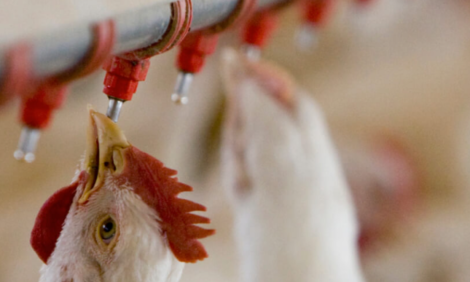



Chicken Infectious Anaemia: Interaction with the Gumboro Disease Virus and its Effect on Birds
GLOBAL - A healthy and responsive immune system of chickens is essential for profitable poultry production. Two pathogens, chicken anemia virus (CAV) and infectious bursal disease virus (IBDV) can negatively influence immune responses without causing clinical disease.CAV, recently classified a member of the Anelloviridae, has a single-stranded circular DNA genome of 2.3 kb coding for 3 viral proteins (VP). VP1 is the only protein in the virus particles. VP2 is essential for the proper folding of VP1, while VP3 causes apoptosis in infected cells. Because the virus does not code for the enzymes needed for DNA replication, CAV can only replicate in dividing cells. Target cells for infection are hemocytoblasts in the bone marrow, T lymphocyte precursors and mature antigen-specific T cells undergoing cell division.
Infection of these target cells results in apoptosis with important consequences for innate and acquired immune responses. Apoptosis of the hemocytoblasts, precursors for red blood cells, heterophils, and thrombocytes, causes a decrease in heterophils and thrombocytes. Because both cell types are important phagocytic cells and producers of cytokines, a decrease can lead to increased bacterial infections and gangrenous dermatitis. The effects on the thymocytes often lead to severe thymus atrophy and a lack of mature helper T (Th) cells and cytotoxic T lymphocytes (CTL). Naïve and memory Th cells and CTL responding to vaccination or infection undergo cell division and become susceptible to CAV resulting in a decrease in Th-dependent antibody responses and CTL-mediated lysis of target cells. Virus-neutralizing (VN) antibodies are crucially important for the control of CAV infection.
Most broiler chickens have maternal VN antibodies against CAV either as a consequence of natural exposure or vaccination of the parent flock and are protected against infection until 2 to 3 weeks of age. However, subclinical infections are frequently occurring after maternal antibodies have weaned. Any immunosuppressive event influencing the development of acquired humoral immunity against CAV will prolong the replication of CAV causing increased damage to the immune system. Exposure to mycotoxins, excessive stress, and/or infection with IBDV including vaccination with intermediate plus vaccine strains are examples that can negatively influence the development of anti-CAV IgY.
IBDV infection or vaccination with “hot” strains will lead to increased cell death of bursacytes, thus negatively influencing the development of immune responses to other pathogens including CAV. However, VN antibodies are also important for the protection against and recovery from IBDV infection. Any decrease in Th cell activity due to CAV infection will negatively influence the development of anti-IBDV IgY antibodies. Experimental studies in SPF leghorn-type chickens have indeed shown that infection with IBDV and CAV can cause increased clinical disease (anemia) and mortality. However, there is a paucity of information on the performance of broiler flocks infected with CAV with or without IBDV. Some authors found a significant negative impact of subclinical CAV infection on production parameters while other researchers failed to detect an impact. Dr. Toro et al (1) has shown that Ark-type infectious bronchitis outbreaks in ArkDPI vaccinated broiler flocks coincided with lymphocyte depletion in the bursa and/or thymus. Subsequent experimental work in commercial broilers confirmed that dual infection delayed recovery in broilers compared to single infections (2).
A major problem in understanding the importance of subclinical immunosuppressive infections is the lack of simple assays to demonstrate immunosuppression. Nonetheless there are enough indications that CAV infection combined with IBDV infection or vaccination causes economical important damage. Protection of broilers against CAV-induced immunosuppression by vaccination will be an important tool to increase productivity. However, vaccination with a live vaccine has two problems.
First, maternal antibodies will interfere with vaccine virus replication for at least 2 to 3 weeks of age similar to the problems with IBD vaccines. The second problem is that a live CAV vaccine will need to replicate in order to induce an adequate immune response. Replication of CAV will cause apoptosis in cells of the immune system and therefore may interfere with immune responses, which could be a problem in short-lived broilers. The solution for a CAV broiler vaccine will need to be based on recombinant or immune complex vaccines, an approach that has been successfully introduced for IBD control.
BIBLIOGRAPHY
- Toro, H., van Santen, V.L., Hoerr, F.J., and Breedlove, C. (2009). Effects of chicken anemia virus and infectious bursal disease virus in commercial chickens. Avian Dis 53, 94-102.
- Toro, H., van Santen, V.L., Li, L., Lockaby, S.B., van Santen, E., and Hoerr, F.J. (2006). Epidemiological and experimental evidence for immunodeficiency affecting avian infectious bronchitis. Avian Pathol 35, 455-464.
K.A. Schat, Professor Emeritus
Department of Microbiology and Immunology, College of Veterinary Medicine,
Cornell University, Ithaca, NY 14853








